|
 Delhi :- Delhi
officially National Capital Territory of Delhi (NCT), is the largest metropolis
by area and the second-largest metropolis by population in India. Delhi
located on the banks of the River Yamuna, is the eighth largest metropolis
in the world by population with 16,753,265 inhabitants in the Territory
at the 2011 Census. There are nearly 22.2 million residents in the greater
National Capital Region urban area (which also includes Noida, Greater
Noida, Ghaziabad, Gurgaon and Faridabad along with other smaller nearby
towns).
Delhi :- Delhi
officially National Capital Territory of Delhi (NCT), is the largest metropolis
by area and the second-largest metropolis by population in India. Delhi
located on the banks of the River Yamuna, is the eighth largest metropolis
in the world by population with 16,753,265 inhabitants in the Territory
at the 2011 Census. There are nearly 22.2 million residents in the greater
National Capital Region urban area (which also includes Noida, Greater
Noida, Ghaziabad, Gurgaon and Faridabad along with other smaller nearby
towns).
Yamuna River Bridge Delhi
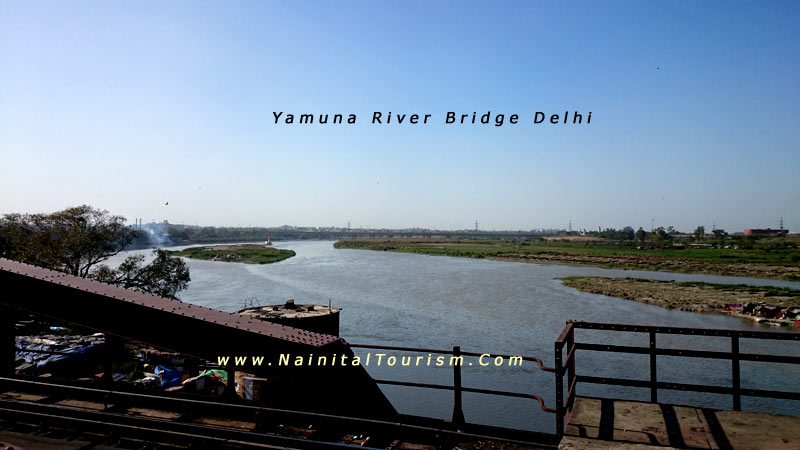
The name Delhi is often also used to include urban areas near the NCT,
as well as to refer to New Delhi, the capital of India, which lies within
the metropolis. Although technically a federally administered union territory,
the political administration of the NCT of Delhi today more closely resembles
that of a state of India with its own legislature, high court and an executive
council of ministers headed by a Chief Minister. New Delhi, jointly administered
by both the federal Government of India and the local Government of Delhi,
is also the capital of the NCT of Delhi.
 Qutab Minar in Delhi - 1860
Qutab Minar in Delhi - 1860
 Qutab Minar & Iron Pillar
Qutab Minar & Iron Pillar
Dilli Hart
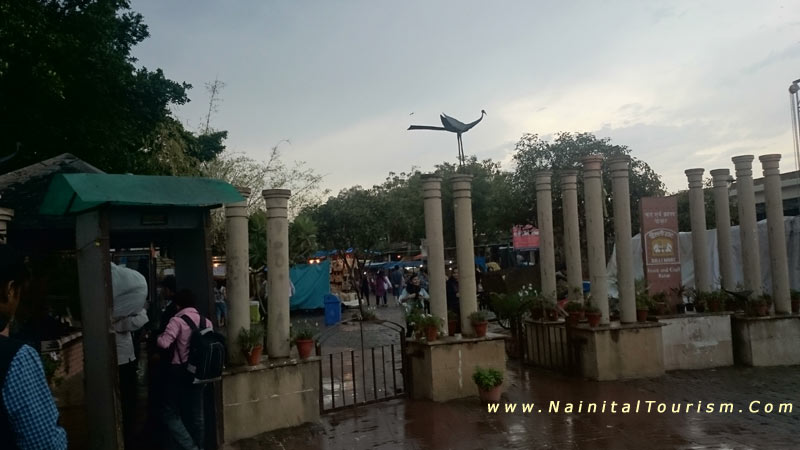
Owing to the migration of people from across the country(mostly from the
Northern and Eastern states of India), Delhi has grown to be a multicultural,
cosmopolitan metropolis. Its rapid development and urbanisation, coupled
with the relatively high average income of its population, has transformed
Delhi into a major cultural, political, and commercial centre of India.
 History of Delhi
History of Delhi
The city is believed to be the site of Indraprastha, legendary capital
of the Pandavas in the Indian epic Mahabharata. Settlements grew from
the time of the Mauryan Empire (300 BC). In 1206, Qutb-ud-din Aybak, the
first ruler of the Slave Dynasty, In 1398, Timur Lenk invaded India entered
Delhi and the city was sacked, destroyed, and left in ruins. In 1526,
Zahiruddin Babur founded the Mughal Empire that ruled from Delhi, Agra
and Lahore for more than three centuries. After the Indian Rebellion of
1857, Delhi came under direct rule of the British crown, New Delhi, also
known as Lutyens' Delhi, was officially declared as the capital of the
Union of India after the country gained independence on 15 August 1947.
 |
 |
 |
| |
 The
Masjid-i Jahan-Numa or Jama Masjid - Delhi 1870
The
Masjid-i Jahan-Numa or Jama Masjid - Delhi 1870
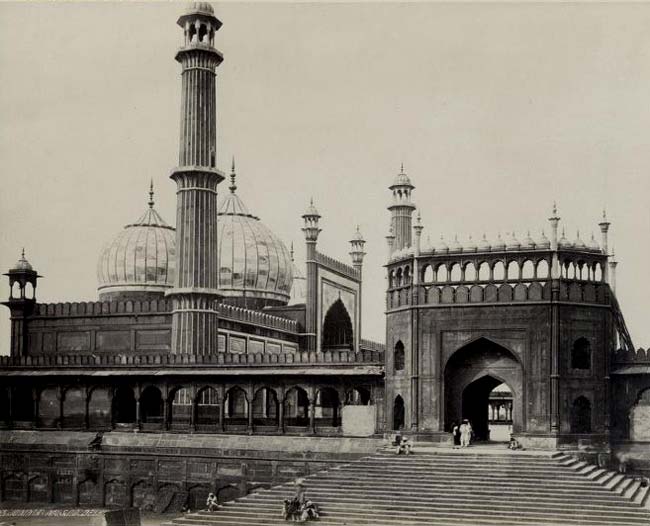 |
|
|
 |
 |
 |
 Geography of Delhi
Geography of Delhi
The National Capital Territory of Delhi is spread over an area of 1,484
km2 (573 sq mi). Delhi is located at 28.61°N 77.23°E, and lies in northern
India.
 Climate of Delhi - Weather of Delhi
Climate of Delhi - Weather of Delhi
Extreme temperatures range from -0.6 °C (30.9 °F) to 46.7 °C (116.1 °F)
Summers are long and extremely hot, from early April to mid-October, with
the monsoon season in between. Early March sees a reversal in the direction
of wind, from the north-western direction, to the south-western. These
bring the hot waves from Rajasthan, carrying sand and are a characteristic
of the Delhi summer. These are called loo. The months of March to May
see a time of hot prickling heat. Monsoon arrives at the end of June,
bringing some respite from the heat, but increasing humidity at the same
time. The brief, mild winter starts in late November and peaks in January
and is notorious for its heavy fog.
 |
 |
 |
| |
 Distant
View of the Jami (Jama) Masjid, Delhi - 1865
Distant
View of the Jami (Jama) Masjid, Delhi - 1865
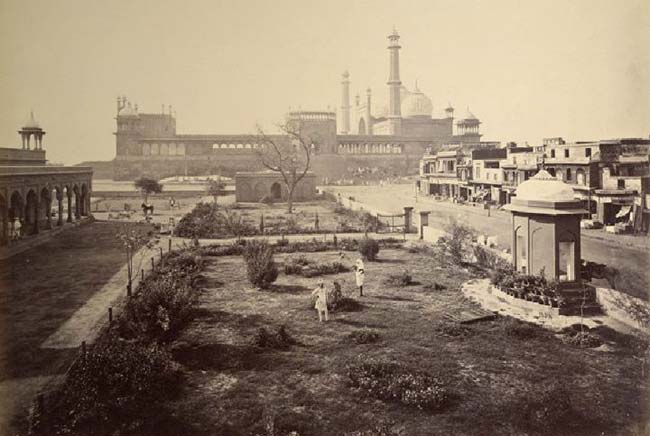 |
|
|
 |
 |
 |
 Tourism In Delhi - Delhi Tourism - Places to visit in Delhi
- Visiting Places - Delhi Sight Seeing
Tourism In Delhi - Delhi Tourism - Places to visit in Delhi
- Visiting Places - Delhi Sight Seeing
Famous for its mixture of historic landmarks, monuments, temples and stylish
Art Deco style buildings, the city of New Delhi is filled with interest.
Amongst the most notable landmarks within New Delhi are the India Gate
a honor to Indian soldiers, the Lotus Temple (Bahai Temple) and also the
President House (Rashtrapati Bhavan).
 |
 |
 |
| |
 A
Rare view of the President's Palace and the Parliament building
in New Delhi -1910
A
Rare view of the President's Palace and the Parliament building
in New Delhi -1910
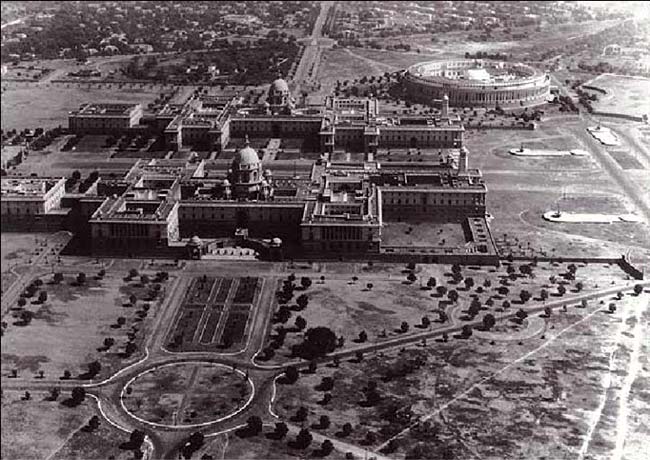 |
|
|
 |
 |
 |
No trip to New Delhi is complete without a photo or two of its famous
Red Fort (Lal Qila), which features a stunning red facade and evening
light shows. Just across from the Red Fort is the Raj Ghat, an official
memorial to India's spiritual leader & Father of Nation, Mahatma Gandhi,
other places of interest are National Gallery of Modern Art, Sanskriti
Kendra, Pragati Maidan, Dilli Haat, Qila Rai Pithora, Hauz Rani, Budayuni
Gates, Ranjit Gate, Tughlaqabad Fort, Adilabad Fort, Nai-ka-Kot Fort,
Dinpanah, Lal Darwaza, Khooni Darwaza, Red Fort, Masjid Moth, Khirki Masjid,
Hauz Khas Pond, National Museum, Indira Gandhi Museum, Raj Ghat, Lodi
Gardens, Chanakyapuri, India Gate, Mughal Gardens, Rashtrapati Bhawan,
Vigyan Bhawan, Parliament House, Birla Mandir and Jantar Mantar.
 Excursions Near Delhi - Delhi Gataways - Weekend Gataways -
Quick getaways from Delhi
Excursions Near Delhi - Delhi Gataways - Weekend Gataways -
Quick getaways from Delhi
Agra, Fatehpur Sikri, Mathura, Brindavan, Damdama, Sultanpur Bird Sanctuary,
Sariska National Park, Bharatpur, Keoladeo Ghana National Park, Nainital,
Kausani, Corbett National Park, Mukteshwar, Mussoorie, Dhanaulti, Jaipur,
Shekawati, Sikar, Fatehpur, Ramgarh, Mahansar, Bissau, Malsisar, Alsisar,
Mandawa, Nawalgarh, and Dundlod, Bikaner, Ajmer, Pushkar and Jodhpur.
India Gate
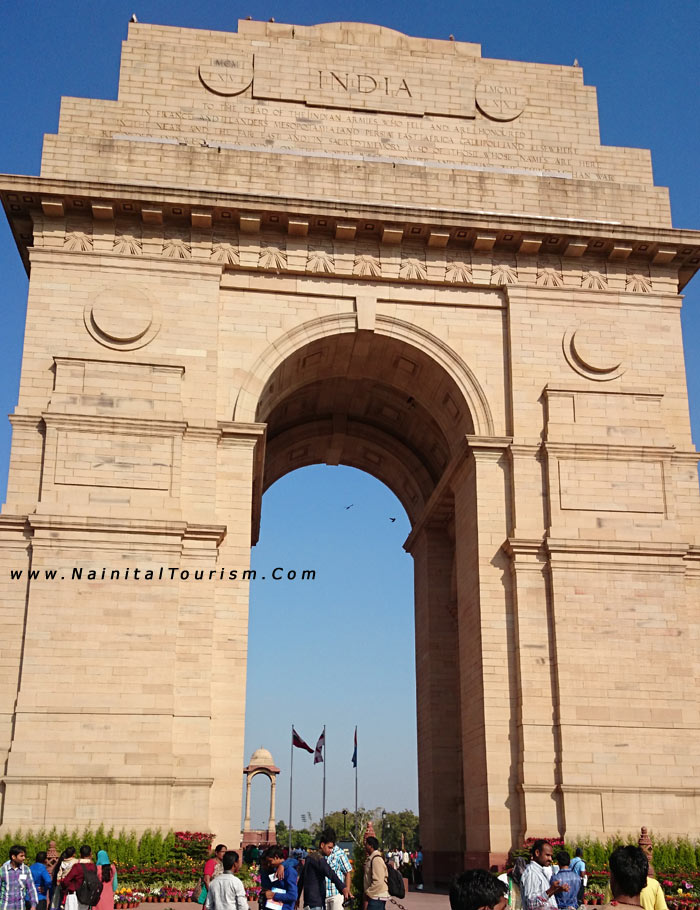
Mughal Garden
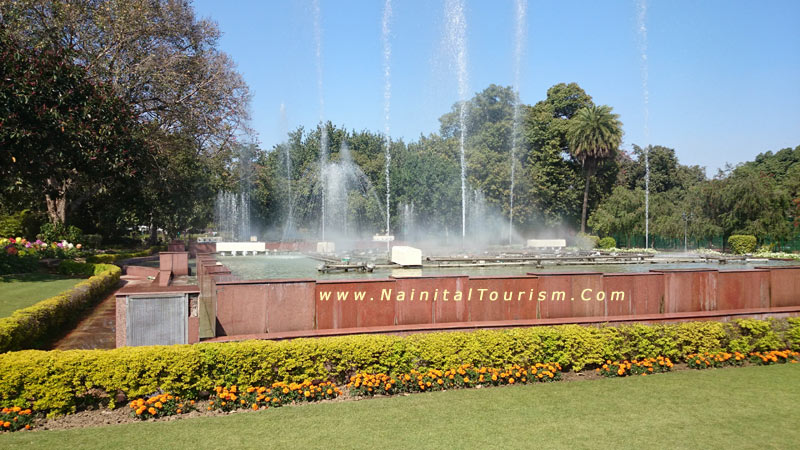
Mughal Garden
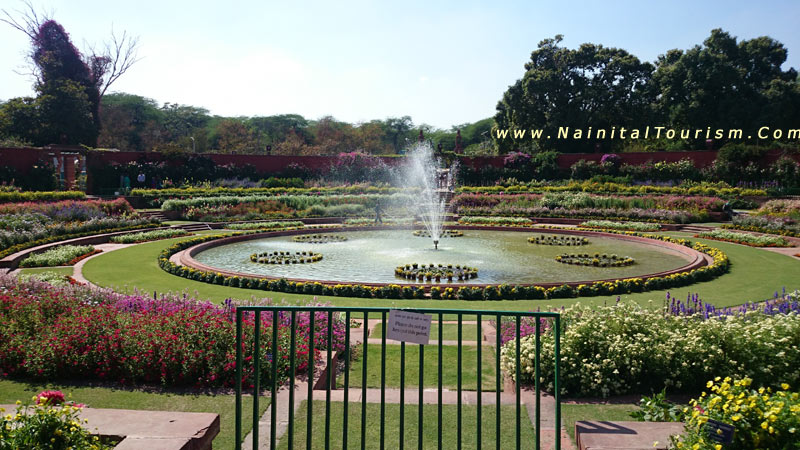
 |
 |
 |
| |
 Arch
and Iron Pillar near Qutub Minar - Delhi - 1850
Arch
and Iron Pillar near Qutub Minar - Delhi - 1850
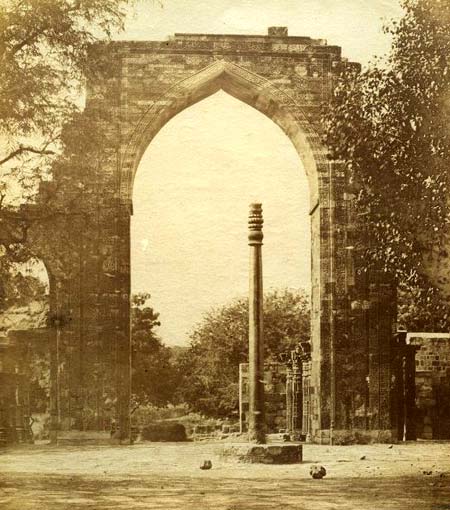 |
|
|
 |
 |
 |
 Transport in Delhi - Delhi Transport
Transport in Delhi - Delhi Transport
Public transport in Delhi is provided by Buses, Auto Rickshaws
and a Metro Rail System.
Buses are the most popular means of transport catering to about 60% of
the total demand. The state-owned Delhi Transport Corporation (DTC) is
a major bus service provider for the city. The DTC operates the world's
largest fleet of environment-friendly CNG buses. Delhi BRTS is Bus rapid
transit serving the city which runs between Ambedkar Nagar and Delhi Gate.

The Delhi Metro, a mass rapid transit system built and operated by Delhi
Metro Rail Corporation (DMRC), serves many parts of Delhi as well as the
satellite city of Gurgaon in the neighbouring Haryana and Noida in neighbouring
Uttar Pradesh. As of October 2010, the metro consists of six operational
lines with a total length of 153 km (95 mi) and 130 stations while several
other lines are under construction. The Phase-I was built at a cost of
US$2.3 billion and the Phase-II will cost an additional US$4.3 billion.
Phase-II of the network is under construction and will have a total length
of 128 km. It is expected to be completed by 2010. Phase-III and IV will
be completed by 2015 and 2020 respectively, creating a network spanning
413.8 km, longer than that of the London Underground.
Auto rickshaws are a popular means of public transportation in Delhi,
as they charge a lower fare than taxis. Most run on Compressed Natural
Gas (CNG) and are yellow and green in colour. Taxis are not an integral
part of Delhi public transport, though they are easily available. Private
operators operate most taxis, and most neighborhoods have a taxi stand
from which taxis can be ordered or picked up. In addition, air-conditioned
radio taxis, which can be ordered by calling a central number, have become
increasingly popular, charging a flat rate of Rs. 15 per kilometre.
 Delhi Railway Station - Railway Station Delhi
Delhi Railway Station - Railway Station Delhi
Delhi is a major junction in the rail map of India and is the headquarters
of the Northern Railway. The five main railway stations are New Delhi
Railway Station, Old Delhi, Nizamuddin Railway Station, Anand Vihar Railway
Terminal and Sarai Rohilla. Delhi is connected to other cities through
many highways and expressways. Delhi currently has three expressways and
three are under construction to connect it with its prosperous and commercial
suburbs. The Delhi-Gurgaon Expressway connects Delhi with Gurgaon and
the international airport. The DND Flyway and Noida-Greater Noida Expressway
connect Delhi with two prosperous suburbs of Noida and Greater Noida.
Indira Gandhi International Airport (DEL) is situated in the western corner
of Delhi and serves as the main gateway for the city's domestic and international
civilian air traffic. In 2006–07, the airport recorded a traffic of more
than 23 million passengers, making it one of the busiest airports in South
Asia. A new US$1.93 billion Terminal 3 handles an additional 34 million
passengers annually in 2010. Further expansion programs will allow the
airport to handle more than 100 million passengers per annum by 2020.
 |
 |
 |
| |
Route
Map To Kausani, Ranikhet, Binsar, Almora from Delhi
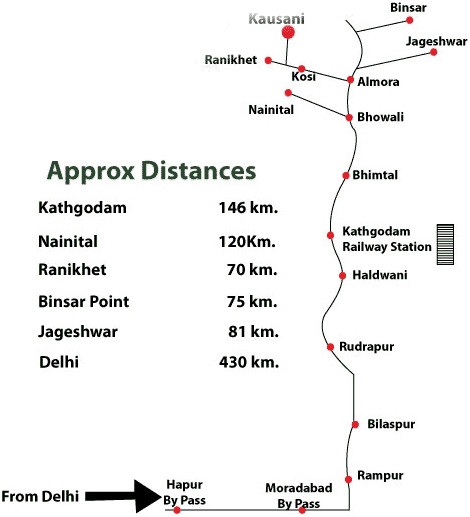 |
|
|
 |
 |
 |
BY
OWN VEHICLE - Delhi - Noida - Gurgaon - Ghaziabad to Nainital
There are basically 2 routes that you can take while going to Nainital
from Delhi. Both the routes run on the same track up to Moradabad
and then deviate after Moradabad. One of the routes is via Kaladungi
and the other goes through Rampur.
Delhi to Nainital through Rampur: Delhi
- Ghaziabad - Hapur - Garmukteshwar - Gajraula - Moradabad - Rampur
- Haldwani - Kathgodam - Nainital
Delhi to Nainital through Kaladungi:
Delhi - Ghaziabad - Hapur - Garmukteshwar - Gajraula - Moradabad -
Tanda - Bazpur - Kaladungi - Nainital
Via Rampur: Rampur route is fine up-to Moradabad but the
major hassle comes while you are crossing Rampur. You have to cross
the busy bazaars of Bilaspur and Rampur to get to Haldwani, which
is even more crowded. From light to heavy vehicles to bullock carts,
you will have to go through a lot of traffic and dirty roads. Definitely
not recommended.
Via Kaladungi: The beauty of this route lies in the fact that
this road is meant for only light vehicles. This further sums up the
fact that there would not be too many heavy vehicles passing by and
that you are pretty much safe on the road. The road condition is absolutely
fantastic and the total distance is only 265 kms. You can easily reach
Nainital in not more than 6 - 7 hours. Definitely recommended!
Moradabad - Nainital Road Map (Via Kaladungi):
After crossing the Moradabad bypass, take a left U turn (the right
turn will go to Rampur) for Corbett National Park. Keep following
the road and it will take a right turn on its own (passing through
a small bazaar) and then after going for about 8 kms more, you will
see a right turn pointing Bazpur. Take this right turn and keep going
straight for Bazpur (landmark: Bazpur Gurudwara just after the rail
track) and then straight on for Kaladungi (passing through a jungle).
On reaching Kaladungi (after crossing a small bridge and going 200
meters ahead) you will see a board pointing left for Nainital. After
taking this right turn you will start climbing up (after 5 kms) and
now you are only 30 kms short of Nainital. |
 Time Taken and Distance from Delhi - Distance Chart - Distance
Between
Time Taken and Distance from Delhi - Distance Chart - Distance
Between
|
Nainital
Tourism offers Pickup & Drop facility
+ online booking for various Hotels & Resorts in Delhi - Nainital
District & Uttarakhand.
 |
 |
 |
| |
Available All Types of Vehicles at Delhi -
Uttarakhand

DELUXE BUSES, INNOVA, INDIGO, INDICA, SUMO, QUALIS, TEMPO-TRAVELER,
TAXIS |
|
|
 |
 |
 |
 |
For
Transport Rates - Hotel Booking in Uttarakhand
or Uttarakhand Tour Packages
Please Call us at  09536-1182-78
or
09536-1182-78
or
 09027-1555-78
(10.30 am - 6 pm) 09027-1555-78
(10.30 am - 6 pm)
Office Landline Number: 05942- 237476 (10.30 am -6 pm)
05942- 237476 (10.30 am -6 pm) |
|
